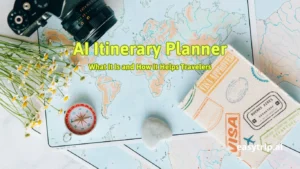Introduction: Crafting the Perfect Journey
Embarking on any trip, whether for a much-needed escape, a thrilling adventure, or a professional engagement, demands careful planning to ensure that every aspect runs smoothly. A well-planned journey can transform travel into a series of memorable experiences rather than a string of stress-filled challenges. This comprehensive guide takes you through each critical step to plan your trip, from your initial daydreams of distant places to the moment you return home with stories to tell.
Step 1: Define Your Travel Goals – The Heart of Your Journey
The first step in planning a successful trip is to clarify your travel goals. What do you hope to gain from this experience? Is it rest and relaxation on a serene beach, the excitement of
exploring a bustling metropolis, or the thrill of pushing your limits through extreme sports? Your goals will shape every decision you make, from selecting your destination to choosing your activities and accommodations. For example, if you’re looking to immerse yourself in new cultures, you might prioritize destinations rich in history and diversity, where local festivals or cultural sites are prominent.
Step 2: Set a Budget – The Blueprint for Your Adventure
Before you dive into booking flights or daydreaming about luxury resorts, it’s essential to establish a clear budget. Your budget will act as the framework within which you plan your entire trip. Start by considering all potential expenses: flights, accommodations, meals, local transportation, entrance fees for attractions, and a contingency for unexpected costs. Using tools like budgeting apps can help keep your finances organized and ensure you stay within your limits. Remember, budgeting isn’t just about cutting costs; it’s about making informed choices that maximize value and enhance your overall experience.
Step 3: Choose Your Destination – Finding Your Perfect Spot
Selecting the right destination is where the magic begins. Your destination should align with both your travel goals and your budget. Start by considering your interests—are you drawn to the natural beauty of the Swiss Alps, the historical allure of Rome, or the vibrant nightlife of Tokyo? Additionally, factor in practical elements such as the weather during your travel dates, any travel advisories, and cultural events you might want to experience. Delve into research using travel blogs, social media platforms, and official tourism websites to gather a well-rounded understanding of what each destination has to offer.
Step 4: Book Flights and Accommodations – Securing Your Journey’s Foundation
With your destination chosen, it’s time to lock in the essential components of your trip—flights and accommodations. Booking these early can save you money and provide a wider range of options. Use travel comparison websites to sift through the myriad of choices, comparing prices, amenities, and locations. When booking accommodations, consider factors like proximity to key attractions, the safety of the neighborhood, and the types of services offered. And don’t forget to read the fine print on cancellation policies, especially if you’re traveling during uncertain times when plans might need to change suddenly.
Step 5: Plan Your Activities – Designing Your Experience
Planning your activities is where your trip begins to take on a personal touch. Start by outlining the must-see sights and experiences that align with your travel goals. Whether it’s a guided tour through ancient ruins, a day at a local theme park, or a quiet afternoon at a world-class museum, booking these activities in advance can prevent disappointment and ensure you make the most of your time. However, it’s equally important to leave some space in your itinerary for spontaneous adventures or much-needed relaxation, allowing for flexibility and the joy of unexpected discoveries.
Step 6: Pack Smart – Preparing for Every Moment
Packing is more than just stuffing your belongings into a suitcase—it’s about preparing for the journey ahead. Create a packing list that reflects your destination’s climate, the activities you’ve planned, and the length of your stay. Aim to pack light, focusing on versatile clothing that can be layered or adapted for different situations. Essential items might include a travel adaptor, a first-aid kit, and toiletries, as well as your electronic devices and their chargers. Don’t forget to include all necessary travel documents, such as your passport, visas, and any required health certifications.
Step 7: Manage Travel Documents – Your Passport to Adventure
Ensuring that all your travel documents are in order is a crucial step that should not be overlooked. Start by checking the expiration dates on your passport and any visas you may need—some countries require that your passport be valid for several months beyond your planned departure date. It’s also wise to have multiple copies of important documents, both physical and digital, in case the originals are lost or stolen. Additionally, consider whether you need travel insurance and ensure that your health documents, such as vaccination certificates or COVID-19 test results, are up to date and meet the requirements of your destination.
Step 8: Local Research – Navigating the Unfamiliar
Understanding the local customs, language, and laws of your destination can significantly enhance your travel experience. Spend some time learning a few basic phrases in the local language, as this can help you connect with residents and navigate more easily. Researching local customs and etiquette will also help you avoid unintentional faux pas and show respect for the culture. Don’t forget to download offline maps, transportation apps, and translation tools before you depart—these can be lifesavers when you’re navigating unfamiliar places or trying to communicate in a language you don’t speak fluently.
Conclusion: The Art of Trip Planning
Meticulous planning is the backbone of any successful trip, transforming a potential minefield of logistics into a smooth, enjoyable journey. By defining your travel goals, setting a realistic budget, choosing the right destination, and organizing your activities and accommodations well in advance, you set the stage for a travel experience that’s both memorable and stress-free. Don’t forget the importance of packing smart, managing your travel documents, and researching local customs to ensure you’re prepared for every aspect of your trip. Whether you’re a seasoned traveler or embarking on your first big adventure, these steps will help you make the most of your journey, turning every trip into a story worth telling.
TL;DR: Key Points in Planning Your Trip
Effective trip planning involves setting clear goals, budgeting wisely, booking early,
planning activities, packing smartly, managing travel documents, and understanding your destination. These steps help ensure a smooth and enjoyable travel experience.
FAQ Section
How far in advance should I plan my trip?
It’s advisable to start
planning your trip 3 to 6 months in advance, especially for international travel, to ensure availability and better rates.
What are the must-have apps for trip planning?
Apps like Google Maps, TripIt, and Google Translate are essential for navigation, itinerary management, and overcoming language barriers.
How can I stay safe while traveling?
Stay informed about your destination’s safety conditions, keep valuables secure, and always have a plan for emergency situations.
Closing Remarks
Thank you for exploring how to plan your trip with our comprehensive guide. Whether you’re embarking on a short getaway or a long adventure, these planning tips will help you navigate your journey confidently and enjoyably. Safe travels!

